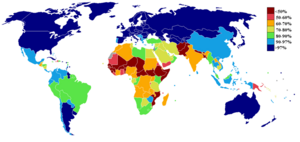Literacy facts for kids
Literacy means being able to read and write. This is a very important skill in today's world. Most people learn how to read and write when they go to school.
Someone who can read and write is called literate. If a person cannot read or write, they are called illiterate.
The UNESCO organization says that illiteracy means a person cannot write or read a simple sentence in any language. In 1998, they guessed that about 16% of people around the world could not read or write.
Contents
Why Some People Are Illiterate
Illiteracy is more common in some parts of the world. This includes countries in the Arabian Peninsula and parts of Africa near the Sahara desert. In these areas, about 30% of men and 40-50% of women might be illiterate.
One reason for illiteracy is that some people can live their lives without needing to read or write. So, they might not feel a need to learn.
Another reason is cultural factors. This means the way a group of people lives. For example, some cultures rely more on oral tradition. This means they share stories and information by speaking, not by writing. A group that mostly herds livestock might not need to read or write for their daily lives.
Types of Illiteracy
There are two main types of illiteracy:
- Primary illiteracy: These are people who have never learned how to read or write at all.
- Functional illiteracy: These people have learned some reading and writing, but not well enough for their daily lives or jobs. For example, they might not be able to fill out a form or understand instructions in a manual. In many industrial countries, functional illiteracy is the bigger problem.
What "Literacy" Means Today
In English, the word "literacy" used to mean being well educated. It also meant knowing a lot about literature (books).
By the late 19th century, "literacy" also started to mean being able to read and write. But it still kept its wider meaning too.
Today, "literacy" means more than just reading and writing words. It also includes being able to understand print, visual (like pictures or videos), and sound texts. To keep learning, students need to be literate in many different ways, not just with written words.
Related pages
Images for kids
-
An ancient Sumerian tablet from around 2600 BC, showing a bill of sale for a slave and a building in Shuruppak.
-
Native American youth at the Carlisle Indian Industrial School in Pennsylvania around 1900.
See also
 In Spanish: Alfabetización para niños
In Spanish: Alfabetización para niños











